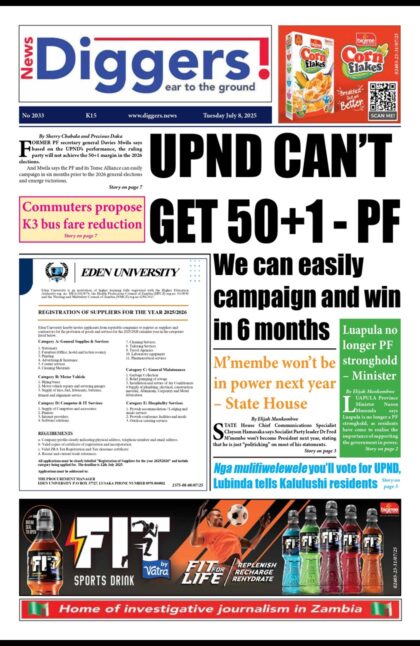Zambia’s debt arising from Chinese loans in the year 2016 rose by 350 per cent from two loans contracted in 2015 to nine the year after, the Zambia Institute for Policy Analysis and Research (ZIPAR) has revealed.
And ZIPAR warned that government’s unrelenting borrowing spree is likely to lead the country to a higher risk of debt distress than what the IMF cautioned in August 2017, and again in February this year.
In its 2018 Working Paper No. 29, presented during an analysis of the 2018 first quarter national budget performance held at Intercontinental Hotel Lusaka, Thursday, ZIPAR disclosed that Zambia’s debt was repeatedly used to finance growing government consumption.
“One significant debt component, which is given surprisingly little direct attention, is Chinese debt. The economic downturn for 2015 and the spending pressure during 2016 appear to have been catalytic in encouraging the Zambian authorities to borrow heavily from easier-going, few questions-asked and more accessible non-traditional development partner funds, particularly from China. The number and monetary value of Chinese loans contracted by the government jumped markedly from 2015 to 2016: (i) whereas the total number of government contracted loans increased by 117 per cent from 12 loans in 2015 to 26 loans in 2016, Chinese loans rose by 350 per cent from two in 2015 to nine in 2016; (ii) as the value of new government loans rose by 39 per cent (from US $2.2 billion in 2015 to US $3.1 billion in 2016) in nominal terms, new loans from China increased by a staggering 259 per cent (from US $484 million in 2015 to US$1.6 billion in 2016); (iii) By end-2016, Chinese loans stood at 35 per cent of total contracted loans in that year compared to 17 per cent in 2015,” the ZIPAR Report revealed.
And the Report also showed that the unrelenting borrowing spree undertaken by the PF government was likely to lead Zambia to a higher risk of debt distress than what the IMF pointed to in August 2017 and in February this year.
“One key aspect of Zambia’s growing public debt has to do with how proceeds are used. Debt is not per se a bad thing; countries borrow to support strategic investments and drive growth. However, notable concerns have arisen that Zambia is not focusing its debt finances strategically; the debt is repeatedly used to finance recurrent expenditure or so-called government consumption. This non-productive spending is exacerbating Zambia’s debt problem and links to issues revealed in section 4.2. Unchecked by the IMF supported economic programme, for instance, the unrelenting borrowing spree is likely to lead Zambia to even higher risks of debt distress than what the IMF pointed to in August 2017 and again in February 2018,” ZIPAR warned.
And ZIPAR, the renowned policy think-tank, noted that Zambia’s Chinese debt could be higher than what the records officially showed.
“Overall, China’s debt stock stood at over US $1.6 billion in 2016, having grown by 12 per cent in nominal terms from the 2015 amount. The Chinese debt was nearly a quarter (23 per cent) of Zambia’s total external debt stock in 2016. Some observers argue that the true size of China’s debt to Zambia is not known and might be higher and growing more rapidly than the records officially show,” the report stated.
Meanwhile, ZIPAR stated that the US $1.2 billion Lusaka-Ndola dual carriageway project was commissioned without a project appraisal, a situation which implied that its economic costs and returns were not well established prior.
“While Cabinet’s decisions showed some level of political will to foster spending restraint, a few outstanding concerns regarding the prudency of fiscal management remained. An example is the commissioning of the Lusaka-Ndola Dual Carriageway project late in 2017, which was expected to ultimately cost US$1.2 billion, or US$3.75 million per km for the 320 km stretch between the two cities. By any global standard or benchmark, this road project was considerably overpriced. Moreover, the project was commissioned minus a project appraisal, implying that its economic costs and returns were not well-established a prior. The marked unresolved issues on such an expenditure-heavy project potentially weakened the credibility and believability of the government’s claim that it had renewed its commitments to fiscal restraint considering the rather lacklustre attention to the project,” it stated.
“Government’s huge spending appetite might eventually be subdued. For instance, in November 2017, the [former] Finance Minister’s [Felix Mutati] ministerial statement to the National Assembly announced that the main outstanding issue under discussion with the IMF was the serious need to scale-up fiscal consolidation measures, particularly expenditure restraint, had been committed to and was being substantially dealt with at the level of Cabinet. Among other things: “…Cabinet, on November 6, 2017, discussed these [debt distress and expenditure restraint] issues and gave a clear policy direction. This included: (a) re-prioritizing projects by concentrating on ongoing projects; (b) re-scoping projects to be implemented in stages to ensure fiscal sustainability; and example is the implementation of Lusaka-Ndola Dual Carriageway, which will be implemented in stages;…in addition, Cabinet resolved the following: (c) no commercial contracts that require debt financing should be signed without Treasury Authority; and (d) tender and legal approvals should not be given where funds are not available.”
ZIPAR also stressed that it was imperative for the authorities to fully explain and justify the hefty cost of the Lusaka-Ndola road project.
“In the case of the Lusaka-Ndola Dual Carriageway, the authorities would do well to give a comprehensive ministerial statement to the National Assembly, fully explaining: (a) the status of the project appraisal; (b) the justification for the hefty price (US$3.75 million per km for the 320 km); (c) the exact amount out of the US $1.2 billion that is concretely guaranteed of a debt commitment by the government; (d) the specific sources and terms of the project financing, including whether or not the physical assets (road and other infrastructure installation like fuel stations and hotels) were used as collateral for any portions of the term financing; and (e) more generally, the pre-contraction measures to be applied to all large or expenditure-heavy on ongoing projects and programmes before loans are taken out, towards rationalizing and fully justifying the loans,” ZIPAR stated.
Meanwhile, ZIPAR noted that government spent US $42 million on purchasing the unbudgeted-for fire tenders, which could also have affected the performance of the national budget.
“Naturally, when it came to light that the government had purchased 42 fire tenders at US $1 million apiece, raking up a total bill of US $42 million (K399 million), the ensuing public outcry was very loud. This outlay was off-budget or unplanned expenditure; it represented a 3.059 per cent variance from the amount budgeted for fire safety and services. Moreover, in June 2017, the Executive issued Statutory Instrument No. 44 of 2017, which designated the town councils of 48 districts across the country as fire authorities for the districts. Considering that SI’s are not vetted or overseen by the National Assembly, they tend to give the Executive greater discretion to change laws without checks and balances,” cautioned the report.
“SI No. 44 of 2017, therefore, raises concerns that the Executive used it to establish new fire authorities simply as a way to absorb unnecessary fire tenders that it had made up its mind to purchase. To date, no record exists that any fire incidences and risk audits or other project appraisal were ever done to inform SI No. 44 on the establishment of new fire authorities or the purchase of the fire trucks. The National Assembly has also never exercised its oversight function to demand a comprehensive and conclusive report on the issue of the fire tenders.”


















